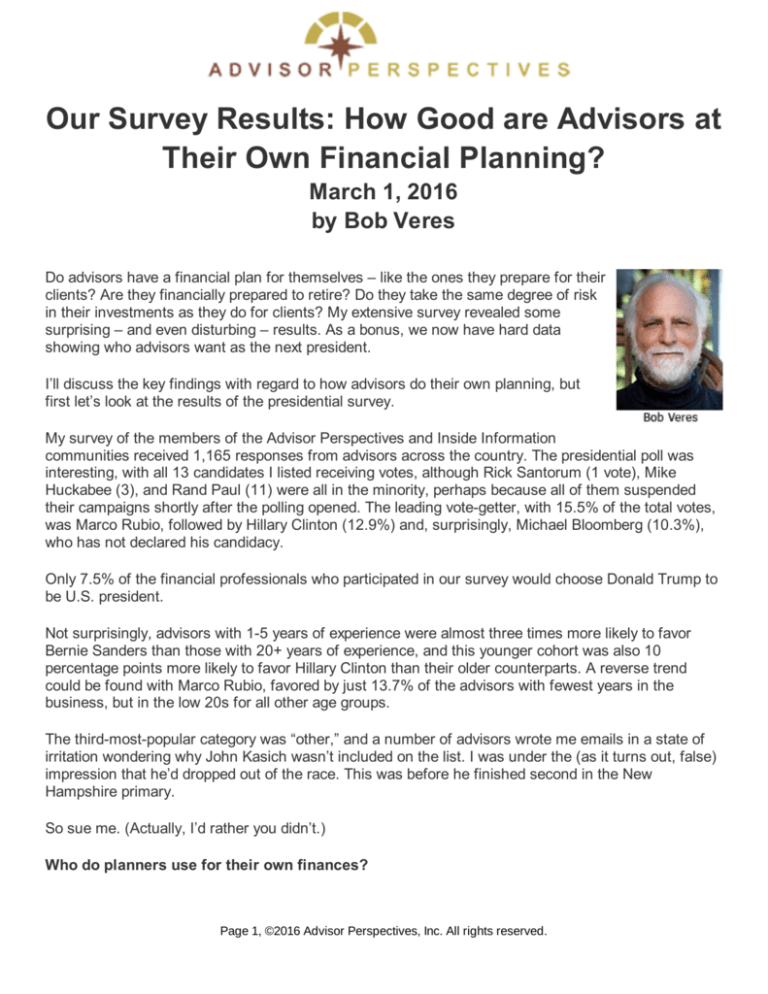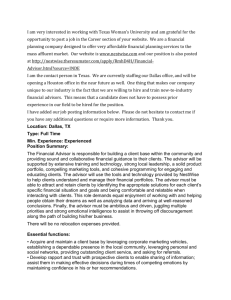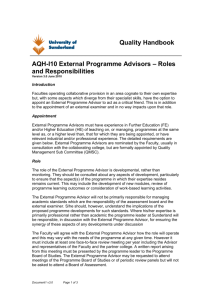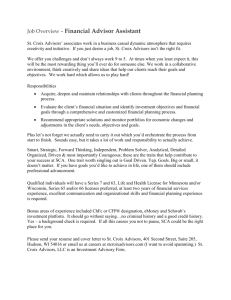
Our Survey Results: How Good are Advisors at
Their Own Financial Planning?
March 1, 2016
by Bob Veres
Do advisors have a financial plan for themselves – like the ones they prepare for their
clients? Are they financially prepared to retire? Do they take the same degree of risk
in their investments as they do for clients? My extensive survey revealed some
surprising – and even disturbing – results. As a bonus, we now have hard data
showing who advisors want as the next president.
I’ll discuss the key findings with regard to how advisors do their own planning, but
first let’s look at the results of the presidential survey.
My survey of the members of the Advisor Perspectives and Inside Information
communities received 1,165 responses from advisors across the country. The presidential poll was
interesting, with all 13 candidates I listed receiving votes, although Rick Santorum (1 vote), Mike
Huckabee (3), and Rand Paul (11) were all in the minority, perhaps because all of them suspended
their campaigns shortly after the polling opened. The leading vote-getter, with 15.5% of the total votes,
was Marco Rubio, followed by Hillary Clinton (12.9%) and, surprisingly, Michael Bloomberg (10.3%),
who has not declared his candidacy.
Only 7.5% of the financial professionals who participated in our survey would choose Donald Trump to
be U.S. president.
Not surprisingly, advisors with 1-5 years of experience were almost three times more likely to favor
Bernie Sanders than those with 20+ years of experience, and this younger cohort was also 10
percentage points more likely to favor Hillary Clinton than their older counterparts. A reverse trend
could be found with Marco Rubio, favored by just 13.7% of the advisors with fewest years in the
business, but in the low 20s for all other age groups.
The third-most-popular category was “other,” and a number of advisors wrote me emails in a state of
irritation wondering why John Kasich wasn’t included on the list. I was under the (as it turns out, false)
impression that he’d dropped out of the race. This was before he finished second in the New
Hampshire primary.
So sue me. (Actually, I’d rather you didn’t.)
Who do planners use for their own finances?
Page 1, ©2016 Advisor Perspectives, Inc. All rights reserved.
Poll respondents were predominately fee-only state-registered or SEC-registered advisors (36.3%) or
dually-registered practitioners (31.2%), giving us a broad spectrum of the financial services profession.
The group also tended to be experienced, with 40.5% having more than 20 years in the business, and
another 23.8% with 11-20 years of experience.
My primary area of questioning could be interpreted as trying to find out whether advisors are like the
cobbler’s children – who, the old saying goes, tend to walk around barefoot while the cobbler takes
care of the paying customers. One presumes that everybody who filled out the survey believes in the
value of professional financial advice, but are they, themselves, willing to buy for themselves the
services they provide for their clients?
In my introduction to the survey, I noted some of the benefits of hiring a financial planner: you have an
outside professional focusing on your financial situation, rather than the afterthought that you might
give to your own circumstances. Your spouse gets a chance to receive the perspective of an outside
professional and participate in your financial planning process. As a professional advisor, you get the
valuable opportunity to experience what it feels like to be on the other side of the desk – which gives
you perspective on how your own clients feel when they’re financially undressing in those first
meetings, and answering difficult questions about their goals and objectives.
Finally, you experience first-hand the service model of an advisor whose work you respected enough to
hire. This can give you ideas on how to improve the service you deliver to your own clients. That, alone,
might be worth whatever you pay for financial planning.
Unfortunately, more than half of our respondents – 54.5% – are not availing themselves of these
benefits; they answered “no” when we asked whether they work with a financial planner. And only
44.9% told us that they, themselves have a financial plan.
A total of 19% of the survey respondents receive financial planning services from another advisor at
their firm, which would give them two of the four benefits listed above. Only 4.3% are working with an
outside planner at another firm – and getting all four benefits listed in my introductory remarks.
When I took a deeper look at the data, I found that slightly more advisors with 20+ years of experience
(27.2%) are getting planning help from their own firms than advisors in other age brackets (20.5% for
11-20 year tenured professionals; 22.2% for those with 6-10 years of experience and 24.1% for those
with 1-5 years in the business). Advisors with 6-10 years of experience were twice as likely as the
other age cohorts to work with an advisor at another firm – 11.1% vs. 4.3% to 5.5% of the other
groups. But the overall percentage was low across all categories. “No” was the dominant answer
across every age group.
The obvious implication is that planners hiring planners from outside their firm is an extremely rare
phenomenon. Very few planners are buying the same services that they provide.
This is extraordinary.
Page 2, ©2016 Advisor Perspectives, Inc. All rights reserved.
I suspect if a poll were taken of attorneys or doctors about the services they respectively provide, the
percentage would be much higher, perhaps close to 100%.
The low percentage of planners hiring planners might be a reflection of the fact that financial planning,
as a profession, is still in its infancy. The more established professions, like lawyers and doctors, have
had enough evolutionary time to create very distinct specialties – so that a general practitioner doctor
would, for example, seek out an ear specialist, or a knee surgeon, when it comes time to address
specific health issues. Similarly, an antitrust lawyer would be unlikely to represent himself in a tort
case.
The financial planning profession hasn’t – yet – created anywhere near this degree of differentiation,
so advisors today are not forced to seek out a specialist for their particular issues. Over the next 10
years, however, two related trends might drive an accelerated trend in this direction.
One is the increasing popularity of teleconferencing using Google Chat or Skype. As the Internet pipes
get bigger and faster, as video screens become larger and sharper, advisors and clients – particularly
the next generation of clients – will start to enter into face-to-screen relationships. It won’t be
necessary for clients to drive to the advisor’s offices in order to have a productive annual or quarterly
meeting.
If client meetings do move from in-person to teleconferencing, it means that advisors will suddenly be
able to work with clients anywhere in the country. There will be no geographic boundaries to the clients’
practice – and that, in turn, means that advisors can begin to pursue increasingly specialized niches,
which may not have been sustainable within a 30-mile radius of their offices.
It will also mean that every advisory firm will be competing with every other advisory firm in the country,
since every one of those other firms will also be bursting out of their geographical boundaries.
Marketing in that environment will increasingly be focused on whether or not the advisor is fluent in the
client’s particular situation, not whether the advisor is a convenient drive away.
One can envision an advisory firm that specializes in providing financial planning for financial planners
– and that 4.3% figure to rise dramatically as that option becomes better-known and understood.
I asked other questions to address the “cobbler’s children” issue in the planning profession. How often
do advisors review their own financial situation?
The survey revealed a broad spectrum of self-diligence. 29.1% of our respondents told us that they
review every quarter; another 14.5% every six months, and 27.3% reported reviewing their portfolio
once a year – which seems a bit neglectful. (One wonders if their spouse is onboard with that level of
care.)
Another 6.9% review their own situation every few years, and seem to fit the “cobbler’s children”
syndrome perfectly.
Page 3, ©2016 Advisor Perspectives, Inc. All rights reserved.
Are advisors financially prepared for their own retirement?
Are the advisors who responded to our survey capable of affording their own retirement with their
current assets? Just 32.3% responded in the affirmative. Another 35.6% are still in the accumulation
phase, and just 1.8% appear to be counting on the sale of their firm to fund retirement.
Not surprisingly, a deeper probe showed that the more experienced advisors with 20+ years in the
business were the most likely to be able to afford retirement: 53.1% of those who responded to the
question, compared with 32% of those with 11-20 years of experience.
Surprisingly, 25.3% of those with 1-5 years in the business and 22.2% of respondents with just 6-10
years of experience are already able to afford their retirement. At the other end of the spectrum, just
28.9% of the 20+ year advisors are still accumulating the necessary assets to retire.
In what I consider to be the most interesting question in the survey, I asked advisors to estimate their
own savings rate: that is, the percentage of their total compensation that they’re putting away for future
use. Here, advisors appear to be far thriftier than the general population. According to Trading
Economics , the average household savings rate is roughly 5.5% in the U.S., after having briefly
resided in the 10% range from early 2009 through late 2013 – as balance sheets recovered from the
high debt levels that preceded the Great Recession.
In contrast, more than 53% of our financial professional survey respondents reported savings rates
above 11%, and 21.2% are saving more than 20% of their income. Since 22% of respondents didn’t
answer the question, the percentage of those who did answer is correspondingly higher: 27.3% report
a savings rate over 20%; 16.5% in the 16-20% range, and 16.5% in the 11-15% range (in other words,
more than twice the national savings rate). 18.8% appear to be saving at the average range for all
Americans.
If you’re looking for the cobbler’s children, consider that 7%, and 2.5% of our respondents report a
savings rate below 5% and around 0% respectively. It’s a small sample size, but it’s interesting to note
that the preponderance of 0% savers had been in the business a long time (19 out of 24 had more
than 11 years of experience), and the same was true of the less-than-5% savers: 58 out of 83. But if
you look more closely at the data, this statistic looks less alarming. Nineteen of the 24 respondents
who were saving nothing reported that they have already saved enough to retire.
Only nine respondents, 0.77% of the total sample, have a zero savings rate and reported that they are
still saving for retirement. Here again, we find a handful of cobbler’s children.
Are advisors investing their own assets differently from the investment recommendations they make
for their clients? 47.2% answered no, and the percentages were pretty consistent across all age
ranges. But another solid plurality – 40.2% – have more equity exposure in their own investment
portfolio than do their clients, while just 2.7% have less. The numbers were pretty consistent across
the age ranges, but I found it interesting that the percentage of advisors with more equity exposure
than their clients was five percentage points lower among planners with 1-5 years of experience than
Page 4, ©2016 Advisor Perspectives, Inc. All rights reserved.
those with 20 or more. We’ve heard that Millennials distrust the market more than their older cohorts;
we may be seeing a faint sign of that in this data.
Meanwhile, the equity exposure disparity among advisors who are willing to hold different portfolios
than their clients is interesting. One explanation – I think the most likely one – is that advisors
understand the investment markets better than their clients, and have accepted the down-market risks
in order to get the higher returns associated with high equity allocations.
If I understand the data compiled by FinaMetrica (the risk tolerance assessment firm) over the past 20
years, there is no reason to believe that advisors, as a subcategory of the human race, have any
greater risk tolerance than the national average. The data collected in our survey suggests that greater
knowledge and familiarity with the markets might be able to influence the willingness to take on risk
something that advisors themselves may have also discovered as they educate their clients about the
investment world.
Other disparities point arrows in roughly the same direction, although the differences are smaller.
Roughly 7.4% of advisors use a greater percentage of actively-managed funds in their own investment
portfolio, compared with 1.9% who go more passive with their personal assets. Twelve point seven
percent of advisors are more tactical with their portfolios compared with their clients; 1.9% report that
they are less tactical with their own assets. A tiny percentage of advisors use more or less bond funds
than they recommend for clients.
What about annuities? Nearly two-thirds (62.4%) of the respondents said they don’t currently own any
annuities in their own accounts, vs. 15.3% who said they do. Then we asked: do you ever recommend
annuities, and there was a clear disparity. Fully 42.3% of the respondents said yes, they do. But before
we take these results as a sign of great hypocrisy among advisors, you should know that I received a
number of private emails about the survey from fee-only advisors who recommend single-premium
immediate annuities (SPIAs) for their retired clients as a way to fund their core expenses, but have not
bought these investments themselves. Why? Because they (the fee-only advisors) aren’t retired yet.
When I looked just at dually-registered advisors, I found that 65% of them own annuities in their own
account, yet just 55% recommend them to their clients. We’re going to have to look for hypocrisy
elsewhere.
Are financial planners good role models for their profession?
What do we make of all this? First, advisors appear to be, on average, champion savers, and an
unexpectedly high percentage appear to be willing to accept more volatility in their own portfolios than
they would recommend for their clients.
But there is unequivocal evidence that they aren’t giving their own financial circumstances as much
attention as they give to those of their clients. Many of them look at their own financial situation with
frequencies that would get them fired if they applied the same formula to their clients, and it is
remarkable that 33% of the total respondent pool said they have no written financial plan. More than
Page 5, ©2016 Advisor Perspectives, Inc. All rights reserved.
half are not currently working with a financial planner.
Based on that evidence, it’s no surprise that only a third of the planners responding to our poll can
currently afford to retire.
If you’re reading this, and you aren’t yet able to retire, consider the advice of some of the respondents
to my earlier message, who have found great value in their outside planning relationships. You might
have been better off if you’d had the good sense to hire a good financial planner who would give your
finances the attention that you give to your clients.
Bob Veres' Inside Information service is the best practice management, marketing, client service
resource for financial services professionals. Check out his blog at: www.bobveres.com. Or check
out his Insider's Forum Conference (for 2016 in San Diego) at www.insidersforum.com.
Page 6, ©2016 Advisor Perspectives, Inc. All rights reserved.







